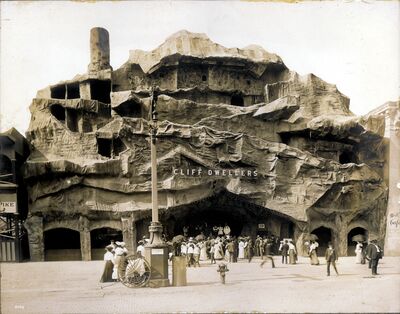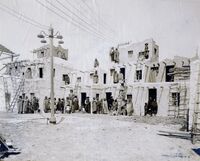Cliff Dwellers: Difference between revisions
No edit summary |
No edit summary |
||
| (3 intermediate revisions by the same user not shown) | |||
| Line 8: | Line 8: | ||
| alternate_name = | | alternate_name = | ||
| location = [[The Pike]] | | location = [[The Pike]] | ||
| no_buildings = | | no_buildings = 12 | ||
| construction_cost= $35,000 (${{Format price|{{Inflation|US|35,000|1904}}}} in {{Inflation/year|US}}) | | construction_cost= $35,000 (${{Format price|{{Inflation|US|35,000|1904}}}} in {{Inflation/year|US}}) | ||
| furnishing_cost = | | furnishing_cost = | ||
| Line 19: | Line 19: | ||
| other = | | other = | ||
}} | }} | ||
The Cliff Dwellers, was a reproduction of the | The Cliff Dwellers, was built on [[The Pike]] as a reproduction of the dwellings of Southwestern Native Americans. Built as a similar attraction to the Cliff Dwellers at the 1893 Exposition at Chicago, the exhibit included twelve replicated structures of a Pueblo village. | ||
==Before the Fair== | ==Before the Fair== | ||
| Line 29: | Line 29: | ||
Returning, visitors will find themselves in the Pueblo of the Taos, covering over five acres of ground, containing over 100 dwellings and peopled by 300 natives of the Moki and Zuni races, including men, women and children, the acknowledged descendants of the original "Cliff Dwellers." | Returning, visitors will find themselves in the Pueblo of the Taos, covering over five acres of ground, containing over 100 dwellings and peopled by 300 natives of the Moki and Zuni races, including men, women and children, the acknowledged descendants of the original "Cliff Dwellers." | ||
[[File:Cliff Dwellers Inside.jpg|200px|thumb|A view inside the Cliff Dwellers.]] | |||
The attraction included a tunnel that patrons descended until they entered a theater (for an additional 25 cents adults 15 cents for children). There, native Indians would perform authentic dances of the Snake and Kachina as well as showcased and sold their artistry of basket weaving, weaving, pottery and silver-work. | The attraction included a tunnel that patrons descended until they entered a theater (for an additional 25 cents adults 15 cents for children). There, native Indians would perform authentic dances of the Snake and Kachina as well as showcased and sold their artistry of basket weaving, weaving, pottery and silver-work. | ||
Latest revision as of 01:37, 21 November 2022
 | |
| Location | The Pike |
|---|---|
| No. of Buildings | 12 |
| Owner | W. Maurice Tobin |
| Construction | |
| Construction Cost | $35,000 ($1.06 million in 2021) |
| Proft | $230,515 ($6.95 million in 2021) |
| Entry | |
| Adult Entry | 25¢ ($8 in 2021) |
| Child Entry | 15¢ ($5 in 2021) |
The Cliff Dwellers, was built on The Pike as a reproduction of the dwellings of Southwestern Native Americans. Built as a similar attraction to the Cliff Dwellers at the 1893 Exposition at Chicago, the exhibit included twelve replicated structures of a Pueblo village.
Before the Fair[edit | edit source]
The Cliff Dweller concession was shown at the 1893 Exposition in Chicago.
Description[edit | edit source]
A massive cliff over 100 feet in height by 250 in length, showed the ancient ruins of the pre-historic race. These ruins were to be 'reached' by a narrow trail up the mountain side, readily accessible to the public, where they could view at close range the abodes of this extinct race. Visitors arrived at the summit of a rather scary incline via burro and gazed at live pueblo Indians of the stone age as well as waxed figures illustrating food gathering, tool-making, etc.
Returning, visitors will find themselves in the Pueblo of the Taos, covering over five acres of ground, containing over 100 dwellings and peopled by 300 natives of the Moki and Zuni races, including men, women and children, the acknowledged descendants of the original "Cliff Dwellers."

The attraction included a tunnel that patrons descended until they entered a theater (for an additional 25 cents adults 15 cents for children). There, native Indians would perform authentic dances of the Snake and Kachina as well as showcased and sold their artistry of basket weaving, weaving, pottery and silver-work.
